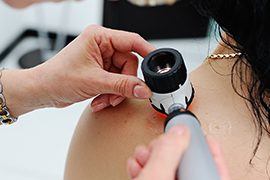Who Gets Skin Cancer… And Why?
The primary cause of skin cancer is ultraviolet radiation—most often from the sun, but also from artificial sources like sunlamps and tanning beds. In fact, researchers believe that our quest for the perfect tan, an increase in outdoor activities, and the potential thinning of the earth’s protective ozone layer are behind the alarming rise we’re now seeing in skin cancers.
Anyone can get skin cancer—no matter what your skin type, race or age. But your risk is greater if…
- Your skin is fair and freckles easily.
- You have light-colored hair and eyes.
- You have a large number of moles, or moles of unusual size or shape.
- You have a family history of skin cancer or a personal history of blistering sunburn.
- You spend a lot of time working or playing outdoors.
- You live closer to the equator, at a higher altitude, or in any place that gets intense, year-round sunshine.
- You received therapeutic radiation treatments for adolescent acne.
Types of Skin Cancer
Basal Cell Carcinoma
The most common type of skin cancer is basal cell carcinoma. Fortunately, it’s also the least dangerous kind—it tends to grow slowly and rarely spreads beyond its original site. Though basal cell carcinoma is seldom life threatening, if left untreated it can grow deep beneath the skin and into the underlying tissue and bone, causing serious damage.
Squamous Cell Carcinoma
Squamous cell carcinoma is the next most common kind of skin cancer, frequently appearing on the lips, face, or ears. It sometimes spreads to distant sites, including lymph nodes and internal organs. Squamous cell carcinoma can become life threatening if it’s not treated.
Malignant Melanoma
A third form of skin cancer, melanoma, is the least common, but its incidence is increasing rapidly. Malignant melanoma is also the most dangerous type of skin cancer. If discovered early enough, it can be completely cured. If it’s not treated quickly, however, malignant melanoma may spread throughout the body and is often deadly.
Other Skin Growths
Two other common types of skin growths are moles and keratoses.
Moles
Moles are clusters of heavily pigmented skin cells, either flat or raised above the skin surface. Most moles pose no danger however, if they have poorly defined borders or mottled colors, they may develop into malignant melanoma. Moles are frequently removed for cosmetic reasons, or because they’re constantly irritated by clothing or jewelry (which can sometimes cause pre-cancerous changes).
Keratoses
Solar or actinic keratoses are rough, red or brown, scaly patches on the skin. They are commonly found on areas exposed to the sun and sometimes develop into squamous cell cancer.
Recognizing Skin Cancer
Basal and squamous cell cancers can vary widely in appearance. Malignant melanoma is usually signaled by a change in the size, shape, or color of an existing mole, or as a new growth on normal skin. Watch for the “ABCDE” warning signs of melanoma:
- Asymmetry—a growth with unmatched halves
- Border irregularity—ragged or blurred edges
- Color—a mottled appearance, with shades of tan, brown, and black, sometimes mixed with red, white, or blue
- Diameter—a growth more than 6 millimeters across (about the size of a pencil eraser), or any unusual increase in size.
- Evolution- a growth that shows subtle changes in size, shape or color over time.
If all these variables sound confusing, the most important thing to remember is this: Get to know your skin and examine it regularly, from the top of your head to the soles of your feet. (Don’t forget your back.) If you notice any unusual changes on any part of your body, have a doctor check it out.
Diagnosis and Treatment
Skin cancer is diagnosed by removing all or part of the growth and examining its cells under a microscope. It can be treated by a number of methods, depending on the type of cancer, its stage of growth, and its location on your body. Small skin cancers can often be excised quickly and easily in our office.
Most skin cancers are removed surgically, by a plastic surgeon or a dermatologist. If the cancer is small, the procedure can be done quickly and easily, in an outpatient facility or the physician’s office with local anesthesia. The procedure may be a simple excision, which leaves a small thin scar, or ED&C (electrodesiccation and curettage) may be performed. In this procedure the cancer is scraped out with an electric current to control bleeding and kill any remaining cancer cells. This leaves a slightly larger scar. In either case, the risks accompanying surgery are low.
If the cancer is large, however, or if it has spread to the lymph glands or elsewhere in the body, major surgery may be required. Other possible treatments for skin cancer include cryosurgery (freezing the cancer cells), radiation therapy (using x-rays), topical chemotherapy (anti-cancer drugs applied to the skin), and Mohs surgery, a special procedure in which the cancer is shaved off one layer at a time. Mohs surgery is performed only by specially trained physicians and often requires a reconstructive procedure as follow-up.
Please see the video below for more information on Mohs Surgery, or visit our Mohs Surgery page
Schedule Your Appointment
Comprehensive Dermatology for the Entire Family.
Schedule your appointment with our dermatology experts today and experience personalized care tailored to your unique needs. Click below to schedule your appointment or call us at the numbers below.

